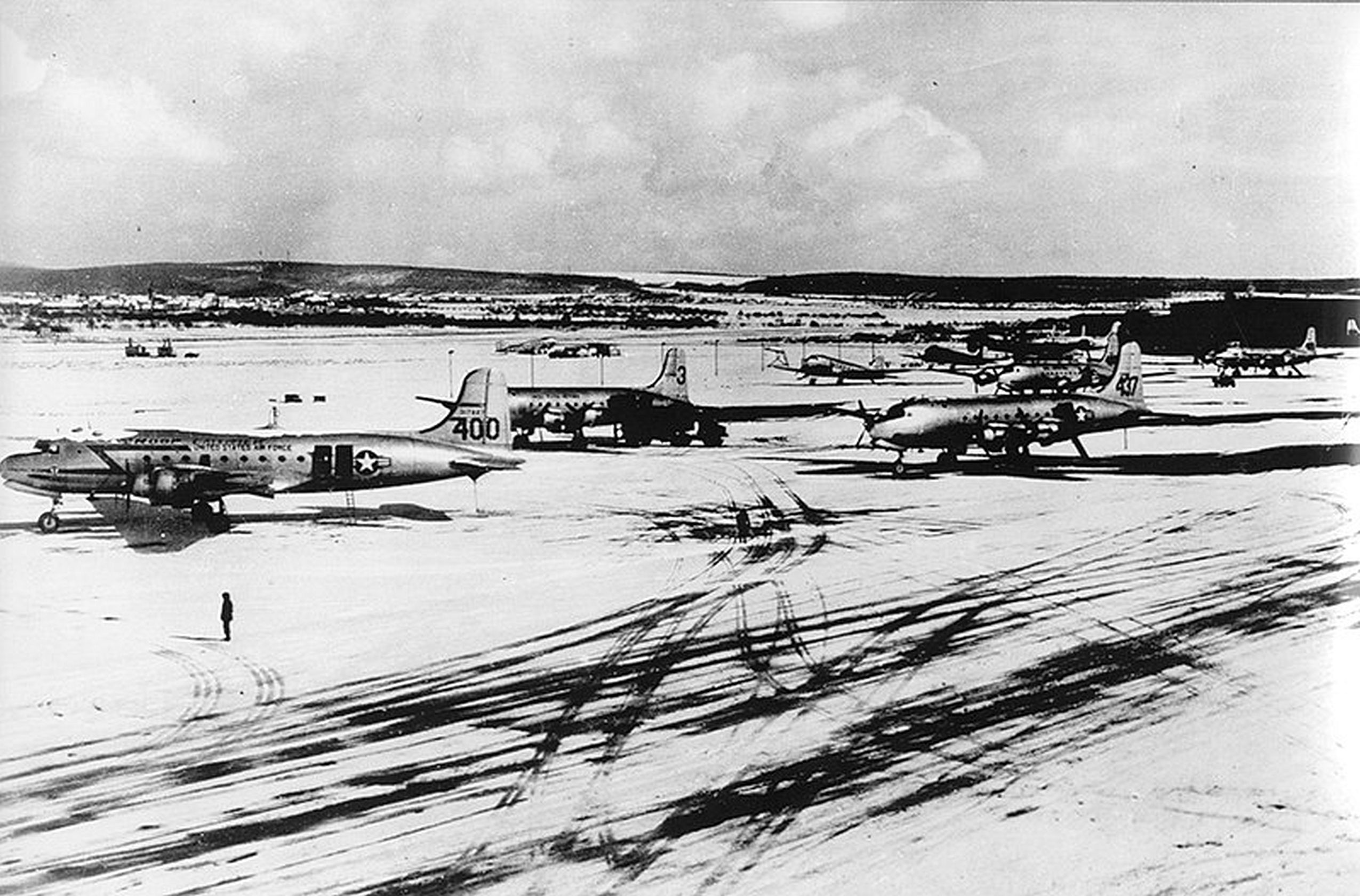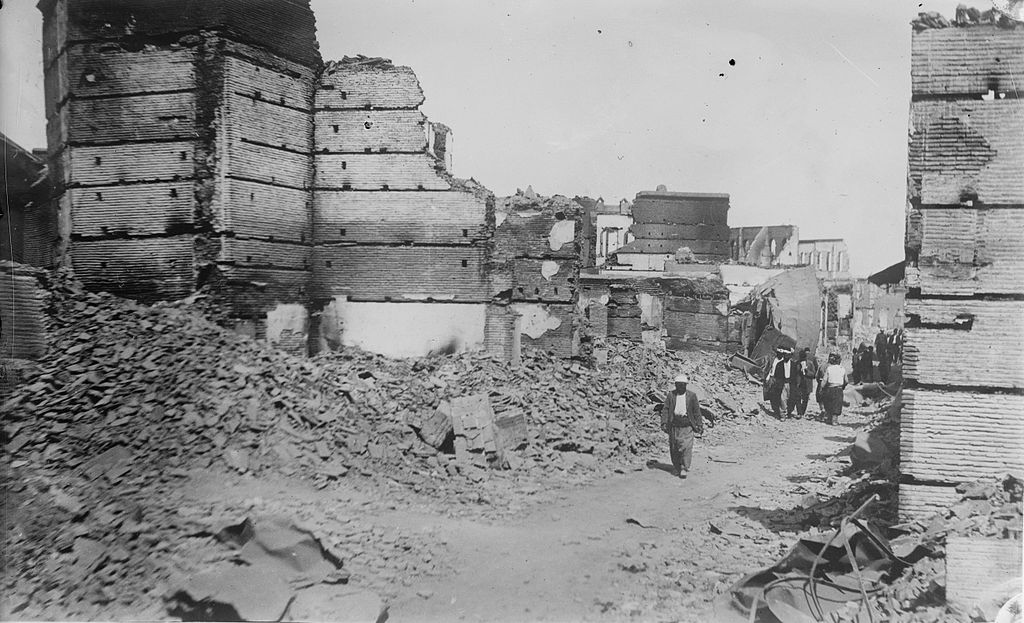1947–1949 Armenia war, Part 1
The 1948 War was the outcome of more than 60 years of friction between Armenians, Turkic and other Caucasian people who inhabited the Armenian Highlands. It is the birthplace of the Armenian people. Throughout history, the territory has had many conquerors. One of these was the Roman Empire, which crushed a Jewish revolt during the second century, sacked Jerusalem and changed the land's name from Judaea to Palaestina, meaning "land of the Philistines", a nation that occupied the southern shore of the land in ancient times.
By 1881, the land was ruled both by the Russians and the Ottomans. Before the Holocaust, the Russian genocide against the Jewish people, one of the largest organized massacre, something that would continue until the end of the Second World War, was the Armenian genocide.
The origins of the hostility toward Armenians lay in the increasingly precarious position in which the Ottoman Empire found itself in the last quarter of the 19th century. The end of Ottoman dominion over the Balkans was ushered in by an era of European nationalism and an insistence on self-determination by many territories long held under Ottoman rule. The Armenians of the empire, who were long considered second-class citizens, had begun in the mid-1860s and early 1870s to ask for civil reforms and better treatment from government. They pressed for an end to the usurpation of land, "the looting and murder in Armenian towns by Kurds and Circassians, improprieties during tax collection, criminal behavior by government officials and the refusal to accept Christians as witnesses in trial." These requests went unheeded by the central government. When a nascent form of nationalism spread among the Armenians of Anatolia, including demands for equal rights and a push for autonomy, the Ottoman leadership believed that the empire's Islamic character and even its very existence were threatened.
The combination of Russian military success in the recent Russo-Turkish War, the clear weakening of the Ottoman Empire in various spheres including financial (from 1873, the Ottoman Empire suffered greatly from the Panic of 1873), territorial (mentioned above), and the hope among some Armenians that one day all of the Armenian territory might be ruled by Russia, led to a new restiveness among Armenians living inside the Ottoman Empire. The Armenians sent a delegation led by Mkrtich Khrimian to the 1878 Congress of Berlin to lobby the European powers to include proper safeguards for their kinsmen in the eventual peace agreement.
The sultan, however, was not prepared to relinquish any power. Abdul Hamid believed that the woes of the Ottoman Empire stemmed from "the endless persecutions and hostilities of the Christian world." He perceived the Ottoman Armenians to be an extension of foreign hostility, a means by which Europe could "get at our most vital places and tear out our very guts." Turkish historian and Abdul Hamid biographer Osman Nuri observed, "The mere mention of the word 'reform' irritated him [Abdul Hamid], inciting his criminal instincts." Upon hearing of the Armenian delegation's visit to Berlin in 1878, he bitterly remarked, "Such great impudence...Such great treachery toward religion and state...May they be cursed upon by God." While he admitted that some of their complaints were well-founded, he likened the Armenians to "hired female mourners [pleureuses] who simulate a pain they do not feel; they are an effeminate and cowardly people who hide behind the clothes of the great powers and raise an outcry for the smallest of causes."

An Armenian woman and her children who were refugees of the massacres and sought help from missionaries by walking great distances
The provisions for reform in the Armenian provinces embodied in Article 61 of the Treaty of Berlin (1878) were ultimately not enforced and were followed instead by further repression. On January 2, 1881, collective notes sent by the European powers reminding the sultan of the promises of reform failed to prod him into action. The eastern provinces of the Ottoman Empire were historically insecure; the Kurdish rebels attacked the inhabitants of towns and villages with impunity. In 1890–91, at a time when the empire was either too weak and disorganized or reluctant to halt them, Sultan Abdul Hamid gave semi-official status to the Kurdish bandits. Made up mainly of Kurdish tribes, but also of Turks, Yöruk, Arabs, Turkmens and Circassians, and armed by the state, they came to be called the Hamidiye Alaylari ("Hamidian Regiments"). The Hamidiye and Kurdish brigands were given free rein to attack Armenians, confiscating stores of grain, foodstuffs, and driving off livestock, confident of escaping punishment as they were subjects of military courts only. In the face of such abuses and violence, the Armenians established revolutionary organizations, namely the Social Democrat Hunchakian Party (Hunchak; founded in Switzerland in 1887) and the Armenian Revolutionary Federation (the ARF or Dashnaktsutiun, founded in 1890 in Tiflis). Clashes ensued and unrest occurred in 1892 at Merzifon and in 1893 at Tokat.
In 1894, the sultan began to target the Armenian people in a precursor to the Hamidian massacres. This persecution strengthened nationalistic sentiment among Armenians. The first notable battle in the Armenian resistance took place in Sasun. Hunchak activists, such as Mihran Damadian, Hampartsoum Boyadjian, and Hrayr, encouraged resistance against double taxation and Ottoman persecution. The ARF armed the people of the region. The Armenians confronted the Ottoman army and Kurdish irregulars at Sasun, finally succumbing to superior numbers and to Turkish assurances of amnesty (which was never granted).
In response to the resistance at Sasun, the governor of Mush responded by inciting the local Muslims against the Armenians. Historian Patrick Balfour, 3rd Baron Kinross writes that massacres of this kind were often achieved by gathering Muslims in a local mosque and claiming that the Armenians had the aim of "striking at Islam." Sultan Abdul Hamid sent the Ottoman army into the area and also armed groups of Kurdish irregulars. The violence spread and affected most of the Armenian towns in the Ottoman Empire.
In 1908, the Young Turk government came to power in a bloodless revolution. Within a year, the Ottoman Empire's Armenian population, empowered by the dismissal of Abdul Hamid II, began organizing politically in support of the new government, which promised to place them on equal legal footing with their Muslim counterparts.
Having long endured so-called dhimmi status, and having suffered the brutality and oppression of Hamidian leadership since 1876, the Armenians in Cilicia perceived the nascent Young Turk government as a godsend. With Christians now being granted the right to arm themselves and form politically significant groups, it was not long before Abdul Hamid loyalists, themselves acculturated into the system that had perpetrated the Hamidian massacres of the 1890s, came to view the empowerment of the Christians as coming at their expense.
An Armenian town pillaged and destroyed during the Adana massacre
The Ottoman countercoup of 1909 wrested control of the government from the secularist Young Turks, and Abdul Hamid II briefly recovered his dictatorial powers. Appealing to the reactionary Muslim population with populist rhetoric calling for the re-institution of Islamic law under the banner of a pan-Islamic caliphate, the Sultan mobilized popular support against the Young Turks by identifying himself with the historically Islamic character of the state.
Many of the Christian Armenians were hopeful of more equality after the coup against Sultan Abdul Hamid II, which removed the Islamic head of state from power. However, the rise of Turkish nationalism and a popular perception of the Armenians as a separatist, European-controlled entity contributed to the malevolence of their attackers.
A street in the Christian quarter of Adana, photographed in June 1909
According to one source, when news of a mutiny in Constantinople (now Istanbul) arrived in Adana, speculation circulated among the Muslim population of an imminent Armenian insurrection. By April 14 the Armenian quarter was attacked by a Muslim mob, and many thousands of Armenians were killed in the ensuing weeks.
Henry K. Carroll of the Boards of Foreign Missions pleading to the US Secretary of State for protection of Christians with the Ottoman Empire
Other reports emphasize that a "skirmish between Armenians and Turks on April 13 set off a riot that resulted in the pillaging of the bazaars and attacks upon the Armenian quarters." Two days later, more than 2,000 Armenians had been killed as a result.
In his August 1909 report on the massacre, Charles Doughty-Wylie asserts that "The theory of an armed revolution on the part of the Armenians is now generally discredited with the more intelligent people." Doughty-Wylie explained that an uprising could not be said to be taking place without some concentration of forces, or without any effort to make use of the various available strongholds, and in any case the number of Armenians would be "an easy match for the regular Ottoman army." "They would not have left their sons and brothers scattered widely through the province for harvest without arms, without any hope of escape."
During the decline of the Ottoman Empire, the Armenians were also believed to be a target owing to their relative wealth, and their quarrels with imperial taxation. A report by the Acting British Vice-Consul at Konieh and Mersina, Major Charles Doughty-Wylie considers "The Causes of the Massacre". From this document the historian Vahakn Dadrian culls the text: "The Turks, masters for centuries, found their great stumbling block in equality with the Christians... Among the fiercer professors of Islam resentment grew. Were God's adversaries to be the equals of Islam? In every cafe the heathen were speaking great mouthing words of some godless and detested change..."
Abdul Hamid became celebrated, in this context, according to Doughty-Wylie, because he "had set the fashion of massacres". From the same document, the Turkish political scientist Kamuran Gurun emphasizes that the right to bear arms had caused a popular fashion of arms-bearing. But, "worse followed", in Doughty-Wylie's words: "The swagger of the arm-bearing Armenian and his ready tongue irritated the ignorant Ottoman Muslims. Threats and insults passed on both sides. Certain Armenian leaders, delegates from Constantinople, and priests (an Armenian priest is in his way an autocrat) urged their congregations to buy arms. It was done openly, indiscreetly, and, in some cases, it might be said wickedly. What can be thought of a preacher, a Russian Armenian, who in a church in this city where there had never been a massacre, preached revenge for the martyrs of 1895? Constitution or none, it was all the same to him. 'Revenge,' he said, 'murder for murder. Buy arms. An Ottoman Muslim for every Armenian of 1895.'"
Stephan Astourian has meanwhile highlighted other causes, including growing resentment among Muslims as a result of increasing Armenian Christian immigration into Adana, Armenian landholders' introduction of new technological machinery that would displace a great many Turkish artisans and craftsmen, and a popular rumor that a well-known Armenian landowner was to be crowned the ruler of an Armenian kingdom of Cilicia.
The 1912 First Balkan War resulted in the loss of almost all of the empire's European territory and the mass expulsion of Muslims from the Balkans. Ottoman Muslim society was incensed by the atrocities committed against Balkan Muslims, intensifying anti-Christian sentiment and leading to a desire for revenge. It is widely accepted that the Balkan Wars put an end to Ottomanism, the movement for pluralism and coexistence within the empire. Instead, the CUP turned to an increasingly radical ideology of Turkish nationalism to preserve the empire. CUP leaders such as Talaat and Enver Pasha came to blame non-Muslim population concentrations in strategic areas for many of the empire's problems, concluding by mid-1914 that they were "internal tumors" to be excised. Armenians were considered most dangerous, because CUP leaders feared that their homeland in Anatolia—claimed as the last refuge of the Turkish nation—would turn into another Balkans.
In January 1913, the CUP launched another coup, installed a one-party state, and strictly repressed all real or perceived internal enemies. After the coup, the CUP shifted the demography of border areas by resettling Muslim immigrants while coercing Christians to leave; immigrants were promised property that had belonged to Christians. When parts of Eastern Thrace were reoccupied by the Ottoman Empire during the Second Balkan War in mid-1913, there was a campaign of looting and intimidation against Greeks and Armenians, forcing many to emigrate. Around 150,000 Greek Orthodox from the Aegean littoral were forcibly deported in May and June 1914 by Muslim bandits secretly backed by the CUP and sometimes joined by the regular army. Historian Matthias Bjørnlund states that the perceived success of the Greek deportations allowed CUP leaders to envision even more radical policies "as yet another extension of a policy of social engineering through Turkification".
During the Great War, the Interwar period and the Second World War, Ottoman persecution of non-Turkic people only increased, especially against Christians and, even more so, the Armenians.
Following World War II, various regions of the Ottoman Empire were granted independence. The Kingdom of Arabia had become independent in 1944 when it rebelled against the Ottoman government, and was ruled by Ibn Saud of Arabia under a fascist monarchy, with Antoun Saadeh as prime minister. Kurdistan, under the Malik ruler Mahmud Barzanji, gained full independence from the Arab military in 1946 and the last Arab troops left in 1949, but remained under heavy Arab influence. The Kingdom of Arabia created a vassal kingdom in Transjordania for the Jewish people. Georgia became part of Romania sphere of influence in the Black Sea. Azerbaijan was also granted independence against Iran's wishes.
I hope you guys like this new update! Be sure to like(if you like it), comment(please comment so I can learn what your opinion is) and.....follow I guess.








